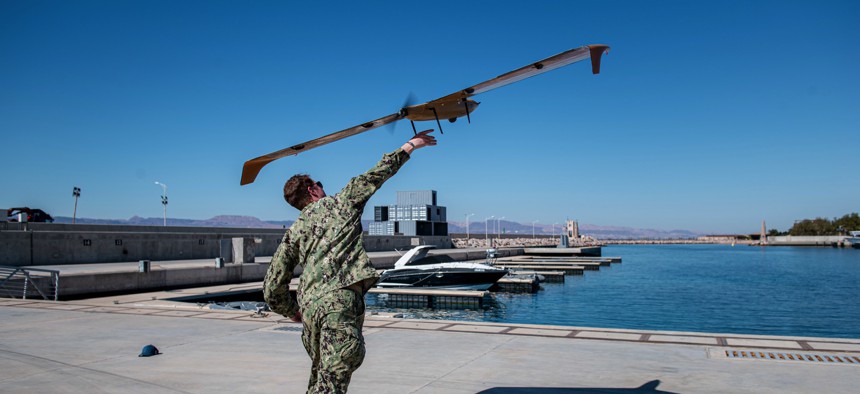
Lt. j.g. Jay Faylo assigned to Task Force 59, launches an M5D Airfox unmanned ariel system during International Maritime Exercise/Cutlass Express 2022. U.S. Navy / Mass Communication Specialist 2nd Class Dawson Roth
As a Groundbreaking Unmanned Task Force Hits Stride, Navy Mulls the Next One
Task Force 59 has earned full operational capability while “normalizing this activity,” 5th Fleet’s commander said.
Now that the Navy’s unmanned-and-AI task force has reached full operational capacity, the service’s top officer is looking to spread its lessons and experimental spirit elsewhere in the fleet.
Adm. Mike Gilday declined to say where the next incarnation of the Persian Gulf-based task force might appear.
“But we are working in that direction. I'll be taking briefs on that shortly. And so, I do want to move quicker in terms of scaling what we're doing at 5th Fleet beyond 5th Fleet,” Gilday said Tuesday at the Surface Navy Association conference in Arlington, Virginia. “I also want to move at bigger problems, large USV, medium USV. I think one of the things that we're learning with the work that is going on at 5th Fleet right now is command and control.”
Elsewhere at the conference, the 5th Fleet commander announced that Task Force 59 had reached full operational capability just 15 months after its creation.
“We're simply in the infancy of a new domain, in normalizing this activity,” Vice Adm. Brad Cooper said.
Since it was established September 2021, the task force has participated in “11 bilateral exercises, three major international exercises, and 30,000 hours of safely operating [unmanned surface vehicles] around the Arabian Peninsula,” Cooper said.
“So, an incredible amount of experience gained in a very short period of time. And I believe…that you can use these new systems combined with artificial Intelligence and see further, see faster, and we can see more efficiently and more effectively, so that we can use the manned ships that we have more efficiently and effectively,” Cooper said.
The USVs in TF59 are commercial, unclassified drones with equipment aboard like sensors and cameras that can be used for navigation, data collection, and intelligence, surveillance, and reconnaissance, Cooper said, that provide data to 5th Fleet to constantly monitor the surrounding waters.
“And if we can do this today, it's not hard to imagine what is possible in the not too distant future. These same systems can be used to support warfighting missions across the entire spectrum of joint warfighting, and that's very exciting,” he said.
The waters that make up Fifth Fleet include major shipping routes and are also contentious due in part to actions by forces from the Islamic Republic of Iran. Last summer, TF 59’s Saildrone Explorers were targeted twice by Iranian forces attempting to steal them. The incidents demonstrated how the U.S. would respond to incidents involving their unmanned systems with other navies, as well as the security threats that could face USVs that have classified equipment aboard.
TF 59 has also worked on how sailors and ships can work alongside these surface drones. Cooper said this “manned-unmanned teaming” is the “foundation” of their use and will be how these drones are used into the future.
The next milestone on the horizon for 5th Fleet is the new drone fleet consisting of platforms from the U.S. and its regional allies. The fleet of 100 unmanned ships is expected to be patrolling by this summer. The U.S. has provided 20 drones towards it, and Kuwait and Bahrain have also promised they would also provide an unspecified amount.
“Integrating new systems together with our partners matters because it will rapidly enhance maritime domain awareness and effectively strengthen regional deterrence, allowing us to focus on key [national defense strategy] priorities,” Cooper said. “Malign actors don't want to get caught in the act, and we have certainly seen that Iran does not like these systems out there one bit, and because Iran does not like it, we love them.”




